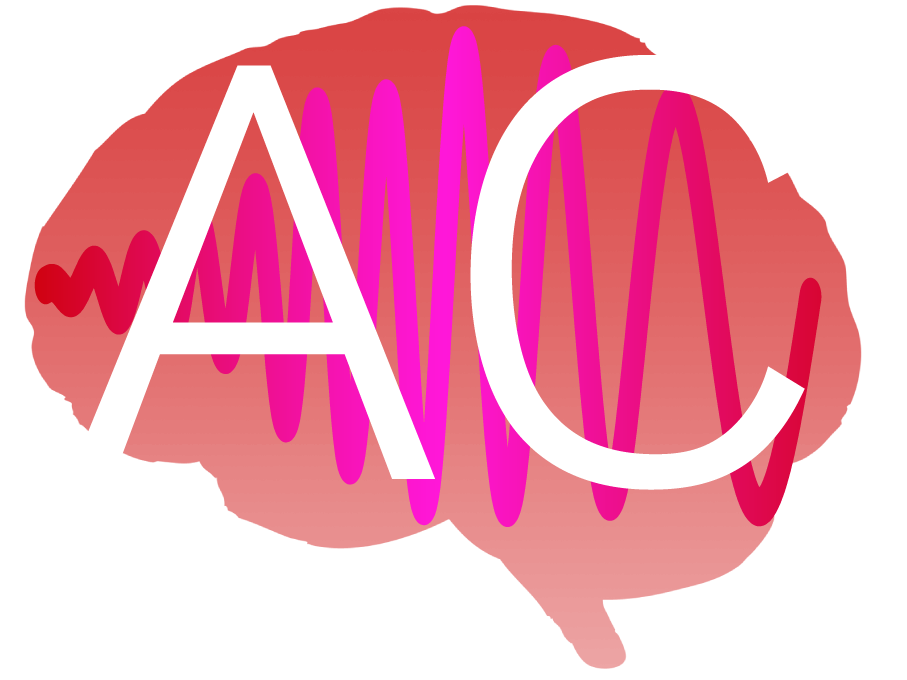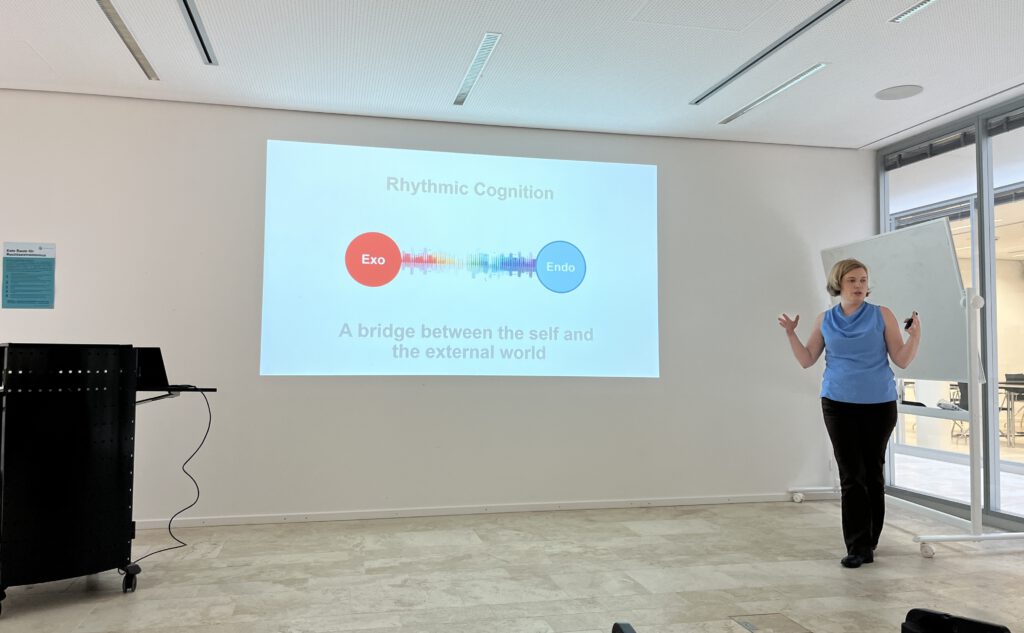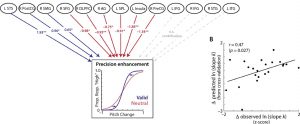Martin Orf is one of three recipients of this year’s EUHA Award for Outstanding Thesis from the European Union of Hearing Acousticians. His thesis, titled “Selective Attention in Multi-Talker Situations: Neural and Behavioral Mechanisms”, offers valuable insights into the neural and behavioural processes behind selective attention in complex listening environments. A key finding of his research is that the neural representation of attended speech becomes stronger when a competing, ignored speech stream is being compressed in its dynamics (a very common yet ill-understood signal processing technique in audio production and also in hearing devices). Martin’s discovery could contribute to the development of future hearing aid algorithms and in the refinement of existing ones.
Category: Attention
These two weeks, we have been fortunate to host two superbe guest talks by Philipp Sterzer from Universität Basel and Ayelet Landau from Hebrew University of Jerusalem here at the Center of Brain, Behavior and Metabolism.
Philipp Sterzer spoke of his rich and intruiging body of work showing how the predictive perceiving mind appears to fluctuate between a more externally-oriented, evidence-seeking mode (my words, JO) and a more internally-oriented mode. Philipp’s studies continue to inspire ongoing work here at our lab, and it was a pleasure to hypothesise about the effects of Ketamine on auditory evidence accumulation. Thanks, Philipp!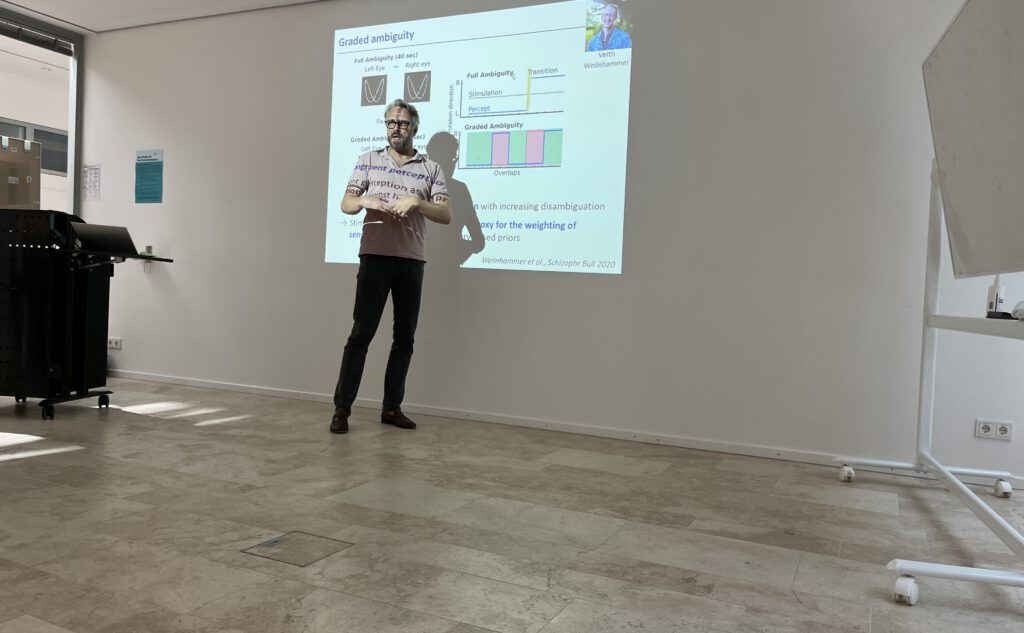 Ayelet Landau presented us with her fascinating account of how internal, endogenous brain rhythms and external, environmental (or other individuals’ brain) rhythms match up and shape the human experience – with thought-provoking links appearing between the organisation of language, states of consciousness, and not least trait-like differences from one person to another. Thanks, Ayelet!
Ayelet Landau presented us with her fascinating account of how internal, endogenous brain rhythms and external, environmental (or other individuals’ brain) rhythms match up and shape the human experience – with thought-provoking links appearing between the organisation of language, states of consciousness, and not least trait-like differences from one person to another. Thanks, Ayelet!
Out now in eLife: Obleserlab stats modelling wiz Sarah Tune together with Jonas has just published a serious statistical piece of evidence on how, in our >N=100 cohort of ageing listeners as funded by the European Research Council, neural signatures of attentive listening and the actual behavioural outcome a listener achieves are not trivially connected, and in fact are not even predictive of one another – when we look at the longitudinal, two-year trajectory that listeners exhibit in both measures over time.
This study (here is a brief eLife digest on it) poses a keystone result to the ERC project “AUDADAPT”, which we now continue with other projects and spin-offs. Many thanks to the large group of Lübeck citizens who continue to support us with their precious time and their brain and behavioural data!
Diese Studie (hier ist eine kurze eLife-Zusammenfassung) ist ein Schlüsselergebnis des ERC-Projekts “AUDADAPT”, das wir nun mit anderen Projekten und Spin-offs fortsetzen. Vielen Dank an die große Gruppe von Lübecker Bürgerinnen und Bürgern, die uns weiterhin mit ihrer kostbaren Zeit und ihren Gehirn- und Verhaltensdaten unterstützen!

Our two senior researchers, Sarah Tune and Malte Wöstmann, are happy to each announce the opening of a three-year PhD position in the Obleser lab. The positions are part of two recently funded DFG grants, and will feature really exciting combinations of behaviour modelling and neural dynamics!
Sarah’s project will look into how perceptual inference changes with age, using speech perception as a model system. It will bring together behavioural speech perception experiments and functional neuroimaging, and apply computational modelling to link between the two.
For full details, see the official job ad.
Malte’s project will focus on auditory attention and its neural bases. It will combine behavioural and electroencephalography (EEG) data in younger and older adults to investigate the neuro-cognitive mechanisms underlying capture of attention and suppression of distraction.
For full details, see the official job ad.
The application deadline (as single PDF to the email address named in the ad!) is Nov 19, 2023!
Please don’t hesitate to contact Sarah or Malte if you have any informal questions about PhD positions and projects. Sarah will also be at APAN and SfN soon, if you feel like chatting with her about the position.
We are looking forward to many interesting applications!
We are honoured and delighted that the Deutsche Forschungsgemeinschaft has deemed two of our recent applications worthy of funding: The two senior researchers in the lab, Sarah Tune and Malte Wöstmann, have both been awarded three-year grant funding for their new projects. Congratulations!
In her 3‑year, 360‑K€ project “How perceptual inference changes with age: Behavioural and brain dynamics of speech perception”, Sarah Tune will explore the role of perceptual priors in speech perception in the ageing listener. She will mainly use neural and perceptual modelling and functional neuroimaging.
In his 3‑year, 270‑K€ project “Investigation of capture and suppression in auditory attention”, Malte Wöstmann will continue and refine his successful research endeavour into dissociating the role of suppressive mechanisms in the listening mind and brain, mainly using EEG and behavioural modelling.
Both of them will soon advertise posts for PhD candidates to join us, accordingly, and to work on these exciting projects with Sarah and Malte and the rest of the Obleserlab team
A ticking clock in the living room; an ambient music in the café; the footsteps of a passersby on the street – We are surrounded by a plethora of distracting events with regular temporal structures in daily life. Can we ignore these distractors better?
Troby Ka-Yan Lui and Malte Wöstmann recently published a study on the effect of temporally regular versus irregular distractors on the ability to maintain items in memory. Surprisingly, they found that the temporal regularity of distractors did not have an effect on participant’s memory performance. Instead, they found an effect of the temporal regularity of distractors on response behaviour – participants were faster and more biased in responding whether the current number matched with the number in memory.
These results have theoretical implications: external distraction may have a more pervasive influence on different aspects of cognitive processes than memory maintenance. The article will soon be available in Scientific Reports.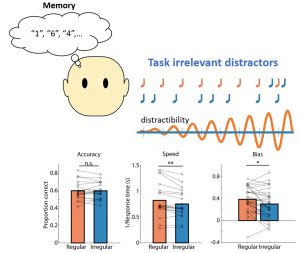
Attention lets us focus our limited cognitive resources on behaviorally important information. Less obvious is that attention also helps us to hold information in memory with high precision. But how does the brain implement this directed attention to memory, and what behavioural benefits does it yield for us humans?
Former postdoc Sung-Joo Lim (now at Binghamton University), Jonas Obleser, and a team of collaborators from Oldenburg (Christiane Thiel) and Leipzig (Bernhard Sehm, Lorenz Deserno, and Jöran Lepsien) have now a new article on this old problem, to appear in NeuroImage.
Using the changes in brain blood oxygenation as measured with fMRI, this study demonstrates that attention enables memory maintenance of speech sound information across multiple brain regions. A speech-sensitive brain region in the temporal lobe (the left superior temporal sulcus) contributes the most in predicting the individual gain in recall precision of auditory objects from memory. This study highlights that functionally discrete brain regions work together in maintaining and attentionally enhancing working memory information, but they exert differental influences depending on their functional specializations.
The full article is now available here.
Former Obleserlab PhD student Leo Waschke is now out in eLife with an ingenious demonstration how both endogenous and exogenously-driven changes in the steepness of the brain-electric 1/f power spectrum (in part linked directly to local excitation:inhibiton, E:I, ratio) in neural populations can affect behaviour in complex, multi-sensory environments: “Modality-specific tracking of attention and sensory statistics in the human electrophysiological spectral exponent”.
The results draw heavily on the recent spectral-slope exponent work by our collaborators at University of California San Diego in the lab of Bradley Voytek, and have come together in a three-lab collabo of Lübeck, San Diego, and Leo’s current scientific home, the Douglas Garrett lab at the MPIB.
Congratulations, Leo!
https://twitter.com/bradleyvoytek/status/1451591258384650244?s=20
